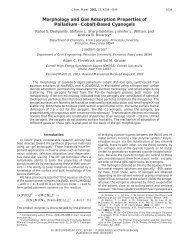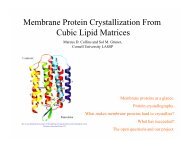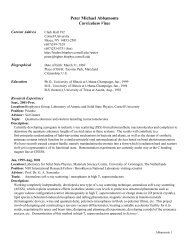Structural and Thermodynamic Characterization of T4 Lysozyme ...
Structural and Thermodynamic Characterization of T4 Lysozyme ...
Structural and Thermodynamic Characterization of T4 Lysozyme ...
You also want an ePaper? Increase the reach of your titles
YUMPU automatically turns print PDFs into web optimized ePapers that Google loves.
The characterization <strong>of</strong> non-native states stabilized under a variety <strong>of</strong> conditions is important towardsunderst<strong>and</strong>ing how proteins fold into their biologically functional, native structures (2). It is widelybelieved that the dominant driving force in protein folding is the hydrophobic effect <strong>and</strong> thatdenaturation can be described as the transfer <strong>of</strong> hydrophobic residues to water. Although thehydrophobic compound transfer model (3-6) largely succeeds in explaining the thermodynamic stability<strong>of</strong> proteins as a function <strong>of</strong> temperature, it does not explain denaturation with pressure (7). In particular,this model fails to explain the magnitude <strong>and</strong> pressure dependence <strong>of</strong> the volume difference between thenative <strong>and</strong> denatured states. Recent simulation studies <strong>and</strong> experimental work suggest that this failure isdue to fundamental differences between the temperature- <strong>and</strong> pressure-denatured states <strong>of</strong> a protein (1,8-12). These studies suggest that unlike thermally <strong>and</strong> chemically denatured states, the pressuredenaturedstate is one in which water penetration into the protein is favorable, <strong>and</strong> that a significantcontribution to the volume reduction with pressure is the hydration <strong>of</strong> internal cavities or packingdefects.The literature raises specific questions that require further study. Is pressure denaturation consistentwith the water penetration model? How does the volume change upon denaturation correlate with cavityvolume? Can other hydration mechanisms be distinguished from cavity filling? What constitutes apressure-denatured state? We attempt to answer these questions by characterizing the pressuredenaturedstates <strong>of</strong> several mutants <strong>of</strong> the protein <strong>T4</strong> lysozyme with varying cavity sizes.<strong>T4</strong> lysozyme is a small globular protein, 164 amino acid residues in length, with a molecular weight<strong>of</strong> 18.6 kDa (Figure 1 (f)) (13). Over 300 X-ray structures <strong>of</strong> <strong>T4</strong> lysozyme mutants have been depositedin the Protein Data Bank, <strong>and</strong> the thermal stabilities <strong>of</strong> many <strong>of</strong> these mutants have been measured (14).Pressure-induced water filling <strong>of</strong> an enlarged hydrophobic cavity in the L99A mutant <strong>of</strong> the pseudowild-type<strong>T4</strong> lysozyme (Figure 1 (b), cavity 6) has been observed by X-ray crystallography (1).Molecular dynamics simulations suggested that four water molecules cooperatively fill this cavity as theapplied hydrostatic pressure is increased (1). No water molecules were observed in the correspondingcavity <strong>of</strong> the pseudo-wild-type, WT* (Figure 1 (a), cavity 6) (1).3









